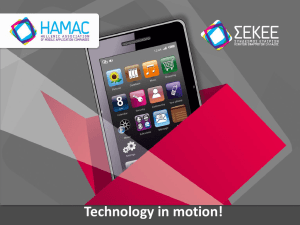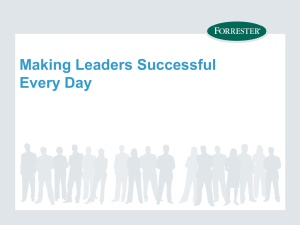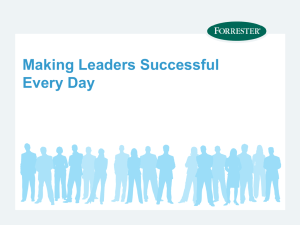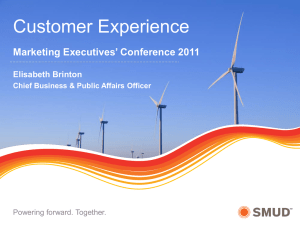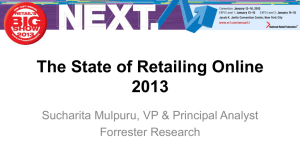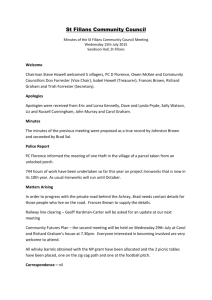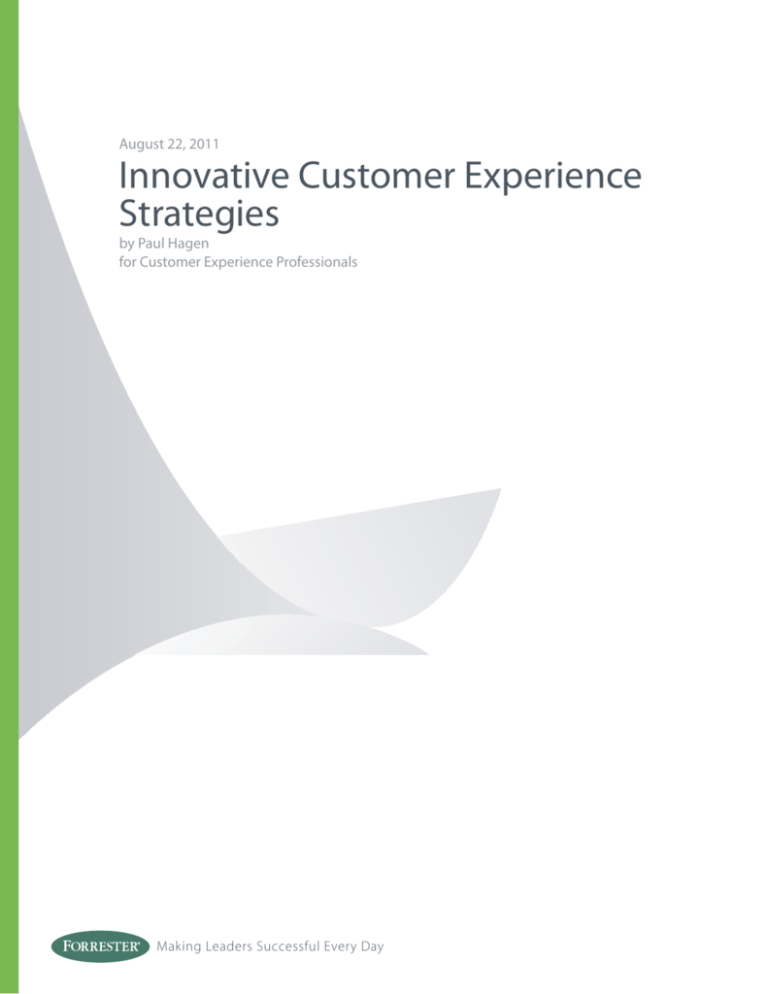
August 22, 2011
Innovative Customer Experience
Strategies
by Paul Hagen
for Customer Experience Professionals
Making Leaders Successful Every Day
For Customer Experience Professionals
August 22, 2011
Innovative Customer Experience Strategies
Companies That Differentiate By Daring To Be Radically Different
by Paul Hagen
with Harley Manning and Allison Stone
Exec ut i v e S u m ma ry
The very nature of competition has changed in the age of the customer. Amid this challenging new
world order, some companies have found ways to compete successfully based on innovative customer
experience strategies that guide the delivery of differentiated value propositions. Forrester uncovered
nine such strategies that align with Michael Porter’s three generic company strategies. They illustrate
some of the many ways firms orchestrate activities to amplify their competitive positions as cost leaders,
differentiators, or segmentors.
tabl e o f Co nte nts
2 Five Forces Disrupt Company Strategy In The
Age Of The Customer
4 Innovative Customer Experience Strategies
Redefine Value Propositions
Cost Leaders Find Creative Ways To Improve
The Experience While Slashing Expenses
Differentiators Extend The Traditional
Boundaries Around Products And Services
Segmentors Compete By Offering An
Exceptional Fit For A Relatively Narrow Market
recommendations
10 Orchestrate Activities To Create An Innovative
Customer Experience
NOT E S & R E S OUR CE S
Forrester interviewed nine vendor companies,
including Acquity Group, Cynergy Systems, The
Engine Group, frog design, IBM, Jump Associates,
R-GA, Rosetta, and Roundarch.
Related Research Documents
“Beyond CRM: Manage Customer Experiences”
April 29, 2011
“The Rise Of The Chief Customer Officer”
January 24, 2011
“What Is The Right Customer Experience Strategy?”
September 28, 2010
10 Supplemental Material
© 2011 Forrester Research, Inc. All rights reserved. Forrester, Forrester Wave, RoleView, Technographics, TechRankings, and Total Economic
Impact are trademarks of Forrester Research, Inc. All other trademarks are the property of their respective owners. Reproduction or sharing of this
content in any form without prior written permission is strictly prohibited. To purchase reprints of this document, please email clientsupport@
forrester.com. For additional reproduction and usage information, see Forrester’s Citation Policy located at www.forrester.com. Information is
based on best available resources. Opinions reflect judgment at the time and are subject to change.
2
Innovative Customer Experience Strategies
For Customer Experience Professionals
Five Forces Disrupt Company Strategy In the age of the customer
More than two-thirds of customer experience leaders recently surveyed by Forrester say that their
firms aim to differentiate based on customer experience.1 But there’s a problem. Differentiation is
about making choices that are different from those made by competitors, but more than half of
respondents lack a customer experience strategy — the critical tool needed to guide their choices.2
To make matters worse, even customer experience professionals who do have strategies find
that what worked before can’t be relied on today.3 That’s because the very nature of competition
is changing as a technology-fueled rise in consumer power transforms the five forces that drive
competitive positioning (see Figure 1).4
August 22, 2011
© 2011, Forrester Research, Inc. Reproduction Prohibited
Innovative Customer Experience Strategies
For Customer Experience Professionals
Figure 1 Michael Porter’s Five Forces Revisited In The Age Of The Customer
Potential
entrants
People become a key supply
element
• Old barriers: Use multiple suppliers
to ensure that no one supplier
has power.
• Change: Key suppliers are people
with talent.
• New threats: Customers follow
talent to competitors.
Suppliers
Barriers to entry are minimal
• Old barriers: They include scale
economies, distribution strengths,
and brands.
• Change: Outsourced manufacturing
and web connections make new
entry easier.
• New threats: Startups challenge
existing leaders.
Competition becomes fiercer
• Old barriers: Markets stabilize with
a few large competitors.
• Change: Perfect real-time
information exists about
competitors’ pricing and practices.
• New threats: Competitors match
moves constantly.
Industry
competitors
Buyers
Technology empowers buyers
• Old barriers: Keep information
hidden from buyers.
• Change: Online tools make buyers
smarter.
• New threats: Buyers dictate terms.
Digital substitutes undermine
industries
• Old barriers: Use manufacturing
scale and pricing to block substitutes.
• Change: Digital technology
generates substitutes.
• New threats: Competition from
companies harnesses disruptive
technology.
Substitutes
Source: June 6, 2011, “Competitive Strategy In The Age Of The Customer” Forrester report
58997
© 2011, Forrester Research, Inc. Reproduction Prohibited
Source: Forrester Research, Inc.
August 22, 2011
3
4
Innovative Customer Experience Strategies
For Customer Experience Professionals
Innovative Customer Experience Strategies redefine Value Propositions
To understand how companies can compete successfully in this new world order, we looked for
firms that are redefining conventional wisdom about customer experience. We identified companies
that push their value propositions to new extremes within the overall framework of Michael Porter’s
three generic company strategies (see Figure 2). They do this by adopting innovative new strategies
for serving the needs of their customers (see Figure 3).
Figure 2 Michael Porter’s Three Generic Company Strategies
Price
Cost
leadership
strategy
Segmentation
strategy
Focus
Product/service
innovation
Differentiation
strategy
Broad
Narrow
Target customer base
58997
August 22, 2011
Source: Forrester Research, Inc.
© 2011, Forrester Research, Inc. Reproduction Prohibited
Innovative Customer Experience Strategies
For Customer Experience Professionals
Figure 3 Innovative Approaches To Customer Experience That Amplify The Value Proposition
Company strategy
Brand promise
Cost leadership strategy
Low prices
Customer experience strategy
Self-service optimization
Ultra-simplification
Crowd-powered
Proactive guidance
Differentiation strategy
Innovation
Data-amplified success
Product as platform
Tailored intimacy
Segmentation
Fit
Micro-niche
Mass customization
58997
Source: Forrester Research, Inc.
Cost Leaders Find Creative Ways To Improve The Experience While Slashing Expenses
In order to compete based on low prices, cost leaders need to create operational efficiencies that
drive down internal cost structures. To do this, they focus on activities that customers value most
while limiting the nice-to-haves. Customer experience strategies pursued by cost leaders include:
·Self-service optimization. Firms that adopt this strategy eliminate the need for customer
interaction with costly human staff by standardizing, streamlining, automating, and bulletproofing processes. Far from feeling cheap, firms that execute this strategy will deliver
experiences that feel efficient, fast, and even personalized. Car-sharing company Zipcar builds
its business on this model. A universal Zipcard allows customers to access any car worldwide.
Customers make reservations from either the Web or a mobile app, which also lets them unlock
the doors or honk the horn remotely (see Figure 4). The firm automatically posts details of the
rental to the customers’ account, which is viewable immediately online.
·Ultra-simplification. Ultra-simplifiers relentlessly cut functions and features that do little for
customers, making it easier to access meaningful value. Witness Omena Hotels, which caters
to guests who want a low-priced room in the center of town as a home base for exploring
a city. Omena eliminates aspects of the overnight experience that its target customers don’t
value much, like a front desk, bellhops, a concierge, restaurants, and room service. An online
registration system automatically generates door keys that it emails or texts to customers,
allowing them to enter the building and go straight to their room upon arrival. And every one
of those rooms has the same economy configuration. The chain shares a single call center open
24 hours a day in the event of problems.
© 2011, Forrester Research, Inc. Reproduction Prohibited
August 22, 2011
5
6
Innovative Customer Experience Strategies
For Customer Experience Professionals
·Crowd-powered. Companies that pursue this approach cut operational expenses by harnessing
customers as if they were employees, in return for a sense of community and co-ownership.
Low-cost mobile operator giffgaff launched in November 2009 as a “people-powered” operator.
With no call center, it uses an online community for customer support, sales and marketing, as
well as product development functions. The operator offers financial incentives for members
to recruit new members and helps them do this by providing banners for display on their
blogs, forum posts, websites, and social network pages. The company’s support community has
an average response time of 3 minutes, 24x7, and the firm attributes 42% of newly activated
accounts to member-driven business development.5
Figure 4 Zipcar Mobile App Allows Users To Make Reservations, Unlock Doors, And Honk The Horn
Source: Zipcar mobile app
58997
Source: Forrester Research, Inc.
Differentiators Extend The Traditional Boundaries Around Products And Services
Differentiators compete by developing innovative, cutting-edge products and services — a position
very different from cost leaders. Far beyond merely adding requested features, these firms leverage
exceptional product and service design talent to develop offerings that customers may not even realize
they need. Innovative customer experience strategies pursued by these types of companies include:
August 22, 2011
© 2011, Forrester Research, Inc. Reproduction Prohibited
Innovative Customer Experience Strategies
For Customer Experience Professionals
·Proactive guidance. Firms that follow this course educate customers and preemptively
solve their problems during every interaction. This helps buyers unlock immediate value
in breakthrough products and services. When Valvoline introduced its NextGen motor
oil — made of 50% recycled oil — the firm orchestrated a wide range of activities to ensure
that its auto-enthusiast customers received its full benefits.6 It created a microsite and blog to
describe the product innovations and used social listening platforms to identify gaps in content.
Additionally, the business-to-business-to-consumer firm conducted an extensive education
campaign of its retail partners.
·Data-amplified success. Companies that pursue this strategy enhance their offerings with
usage data and advice that push well past traditional product or service boundaries. Crown
Equipment, one of the world’s largest forklift manufacturers, embeds sensors into its equipment
and sends utilization information to a centralized software application that helps business
managers maximize the efficiency of their company’s warehouse operations. Similarly, Nike
became an enabler of a broader customer goal — fitness rather than just a shoe purchase. With
its Nike+ device and services, the firm tracks workouts and connects users to competitions. This
defends it against substitute products by making customers consider whether they’re willing to
abandon that data when thinking about buying shoes from a competitor.
·Product as platform. Firms pursuing this strategy include Apple, Google, Facebook, and
salesforce.com. They enable others to innovate on top of their products to create an experience
that’s limitless, adaptable, and integrated. Similarly, Recon Instruments — a company that makes
sports eyewear products — is building its next version of a digital companion for sports goggles
on the Android OS. The firm is opening up its application programming interface to allow others
to develop applications using the data it collects. This will allow enthusiasts to create innovative
applications for customers beyond what Recon Instruments could deliver on its own.
Segmentors Compete By Offering An Exceptional Fit For A Relatively Narrow Market
Unlike cost leaders and differentiators, segmentors compete by offering products and services that
are tailored to a relatively narrow market. Innovative segmentors compete through some of the
following customer experience strategies:
·Tailored intimacy. Companies that adopt this strategy seek to create deep connections with
customers through interactions that are attuned, empathetic, and personalized. Box Home
Loans targets customers with credit scores higher than 700 who want to purchase owneroccupied property. It appeals to this select group by offering a high level of services along with
its very low rates (see Figure 5). The same loan officer who provides the original quote stays with
the customer throughout the application process and calls or emails every two to three days to
provide a status update. An online account area provides contact information to both the loan
officer and the processor assigned to the borrower as well as a customized checklist of needed
items.
© 2011, Forrester Research, Inc. Reproduction Prohibited
August 22, 2011
7
8
Innovative Customer Experience Strategies
For Customer Experience Professionals
·Micro-niche. Firms that follow this path deliver an experience that goes above and beyond
for customers who adopt a distinctive lifestyle or belong to a specific business culture. The
“whatever/whenever” promise of Starwood Hotels & Resorts Worldwide’s W Hotels sets the
stage for a comprehensive experience geared toward young and trendy urban professionals.
How above and beyond will the hotel go to create experiences that exceed expectations? One
W hosted a private runway show for a guest who wanted to surprise her girlfriends with a
sneak peak at upcoming fashions. To deliver on its promise, the company encourages staff to
poach “fun, fresh, and flirty” employees from hip local bars and restaurants who will reflect the
lifestyles of its target clientele.
·Mass customization. Companies that pursue this strategy let customers tailor a product’s
appearance, features, or content to their own specifications. This results in experiences that
are unique and remarkably self-expressive.7 In fact, behavioral studies suggest that customers
who engage in customization view these products as part of themselves (see Figure 6).8 Take
mymuesli, which offers buyers the chance to select combinations of grains, fruits, spices, and
candies that match their tastes. Among every 100,000 orders, mymuesli finds that only 42 are
identical.9 Similarly, Zazzle — a vendor of 48 different mass-customized product categories —
offers customers the opportunity to imprint their own personalized designs on iPhone cases that
ship within 24 hours.10
Figure 5 Box Home Loans Targets Specific Customers
Source: Box Home Loans website
58997
August 22, 2011
Source: Forrester Research, Inc.
© 2011, Forrester Research, Inc. Reproduction Prohibited
Innovative Customer Experience Strategies
For Customer Experience Professionals
Figure 6 Mass Customization Accrues Psychological Benefits To Customers
I feel a sense of
accomplishment
because I designed it
myself.
I feel a greater sense of
psychological ownership
because I designed it
myself.
Creating it myself
incorporates the product
into my “extended self.”
If someone else had
made the same object,
I wouldn’t care as much.
But I value it because
I made it myself.
When I design the
product myself, it has more
personal value to me.
I can express myself
through this product
when I am in public.
Customer of
mass-customization
product
I am happier with the
features I got because
I know I need them.
Source: Nikolaus Franke, Martin Schreier, and Ulrike Kaiser, “The ‘I Designed It Myself’ Effect in Mass
Customization,” Management Science, January 2010
58997
© 2011, Forrester Research, Inc. Reproduction Prohibited
Source: Forrester Research, Inc.
August 22, 2011
9
10
Innovative Customer Experience Strategies
For Customer Experience Professionals
Rec o m m e n da t i o n s
Orchestrate Activities To Create An Innovative Customer Experience
To deliver innovative experiences that create meaningful value for customers and also further the
business objectives of the company:
·Begin with a customer experience strategy. To craft their own innovation plans, customer
experience leaders should start by reviewing their overall company strategy and brand
promise. This exercise should reveal target customers, the value proposition for those
customers, and the key activities performed today to deliver that value. If it doesn’t, possibly
because corporate strategy is in flux, they can create a proxy based on a combination of
their personas, voice of the customer data, and journey maps. Armed with that insight, they
can write a vivid description of the experiences they want customers to have, being sure
to include emotional components that tie back to the core value proposition like “feels just
right for me” or “inspires trust.”
·Map the customer experience ecosystem. No single person is responsible for a customer’s
experience. Rather, it is a complex set of relationships among employees, partners,
and customers that determines the quality of all interactions. Forrester refers to these
interconnected relationships as the customer experience ecosystem.11 In order to align the
needs of all of these players, customer experience professionals should map their ecosystems,
starting with one painful journey of an important customer. This activity will not only reveal
opportunities for innovation but also make behind-the-scenes players in departments like
marketing, logistics, and legal aware of how they affect frontline interactions.
·Embrace only those new capabilities that are on-strategy. Customer experience
professionals should use their strategy and ecosystem map to guide decisions about deploying
emerging capabilities like mobile, social, gamification, crowdsourcing, and other customer
engagement innovations. All of these developments are right for some companies and wrong
for others. Firms can avoid wasting valuable time and resources by judging these new
capabilities based on whether or not they create the specific value that customers seek from
their company and create this value more successfully than other choices they could pursue.12
Supplemental MATERIAL
Companies Interviewed For This Document
Acquity Group
R-GA
Cynergy Systems
Rosetta
frog design
Roundarch
IBM
The Engine Group
Jump Associates
August 22, 2011
© 2011, Forrester Research, Inc. Reproduction Prohibited
Innovative Customer Experience Strategies
For Customer Experience Professionals
Endnotes
1
To assess the state of customer experience in 2011, Forrester surveyed 118 customer experience
professionals around the globe. More than two-thirds said that their firms aim to differentiate based on
customer experience. But most companies are ill-prepared to compete on that basis. Not even half have a
companywide program to improve customer experience across channels, and only 30% have a dedicated
budget to fund those efforts. However, there is hope. We found that having a centralized customer
experience team and appointing a single executive to be in charge of customer experience helps knock
down barriers to success. See the February 17, 2011, “The State Of Customer Experience, 2011” report.
2
To craft their strategies, customer experience leaders should start with their firms’ overall strategies that
define competitive positions and set customer expectations of the brand. To illustrate this approach, we
describe three customer experience strategies that align with Michael Porter’s generic company strategies:
1) self-service optimization for cost leaders; 2) proactive guidance for product or service differentiators; and
3) tailored intimacy for segmentors. See the September 28, 2010, “What Is The Right Customer Experience
Strategy?” report.
3
The shifting competitive forces can put firms at risk. Companies like Barnes & Noble and Borders
Properties that once enjoyed competitive barriers such as geographic location and a difficult-to-match
merchandise selection struggle to stay in business because the experience of convenient locations, a
relatively large selection, and a nice cup of coffee can’t overcome the experience of the vastly larger selection,
lower prices, streamlined ordering process, and rapid delivery of Amazon.com. Digital-only products
challenge a wide range of industries from media to banking and retail. Even big-iron industries like
equipment manufacturing, once thought safe because of high startup costs, will come under increasing
pressure once open-source design and new technologies like 3D printing allow new businesses to create
everything from plastic molds to farm machinery.
4
We analyzed the five forces that Michael Porter cites in Competitive Strategy that many view as the definitive
guide to competitive strategy. Examining these forces reveals that an obsession with customer knowledge
and relationships is the only source of sustainable competitive advantage and found that: 1) Barriers to
entry are lower; 2) substitute products and channels are gutting profits; 3) buyers have more power than
ever; 4) employees, a key element of supply, have increasing power over companies; and 5) competitors now
have instant access to your tactics and strategies. See the June 6, 2011, “Competitive Strategy In The Age Of
The Customer” report.
5
Giffgaff, a low-cost mobile virtual network operator, uses an online community for customer support, sales
and marketing, as well as product development functions. To ensure a positive customer experience for
advanced community users and value-driven customers who aren’t used to online communities, giffgaff
determined the ideal high-level attributes of the community to support its brand and focused on educating
and incenting members to participate in a positive way. See the May 19, 2011, “Giffgaff Manages Its
Community To Deliver A Great Customer Experience” report.
6
Interactive marketing agency, Rosetta, worked with Valvoline to develop and deliver the digital aspects of its
strategy.
© 2011, Forrester Research, Inc. Reproduction Prohibited
August 22, 2011
11
12
Innovative Customer Experience Strategies
For Customer Experience Professionals
7
Changes in customer-facing technology are opening up new opportunities for product strategists to bring
customers into product design, creating both customer loyalty and higher margins. While it will take a
decade for mass customization to become widespread, product strategists should seize the opportunity
to be first movers today. Product strategists can build successful mass-customization strategies by
applying Forrester’s CURA framework: curation, usability, resonance, and anticipation. Ultimately, mass
customization holds the promise of helping bring manufacturing back to the US and EU due to the need
for local production and highly skilled labor. See the April 15, 2011, “Mass Customization Is (Finally) The
Future Of Products” report.
8
A group of social scientists developed the “I Designed It Myself ” concept (and term) through studies of the
psychology of mass customization via psychological experiments in academic studies. Source: Nikolaus
Franke, Martin Schreier, and Ulrike Kaiser, “The ‘I Designed It Myself ’ Effect in Mass Customization,”
Management Science, January 2010.
9
Source: mymuesli (http://uk.mymuesli.com).
10
Source: Zazzle (http://www.zazzle.com/).
11
Even companies that make customer experience a strategic priority struggle to implement major longlasting improvements. That’s because they fail to connect behind-the-scenes activities to customer
interactions. These firms need a new approach to customer experience management: one that considers the
influence of every single employee and external partner on every single customer interaction. Forrester calls
this complex set of relationships the customer experience ecosystem. See the June 22, 2011, “The Customer
Experience Ecosystem” report.
12
Customer experience leaders must deliver maximum return on the investments that they make for
the business. To help them do that, Forrester has identified a set of best practices that firms can use to
evaluate and rank customer experience projects. We found that the decision criteria must have four key
characteristics in order to tease out the best mix of projects: clarity, simplicity, balance, and flexibility. See
the February 12, 2010, “Managing The Customer Experience Project Portfolio” report.
August 22, 2011
© 2011, Forrester Research, Inc. Reproduction Prohibited
Making Leaders Successful Every Day
Headquarters
Forrester Research, Inc.
Research and Sales Offices
Forrester has research centers and sales offices in more than 27 cities
400 Technology Square
internationally, including Amsterdam; Cambridge, Mass.; Dallas; Dubai;
Cambridge, MA 02139 USA
Foster City, Calif.; Frankfurt; London; Madrid; Sydney; Tel Aviv; and Toronto.
Tel: +1 617.613.6000
Fax: +1 617.613.5000
Email: forrester@forrester.com
For a complete list of worldwide locations
visit www.forrester.com/about.
Nasdaq symbol: FORR
www.forrester.com
For information on hard-copy or electronic reprints, please contact Client Support
at +1 866.367.7378, +1 617.613.5730, or clientsupport@forrester.com.
We offer quantity discounts and special pricing for academic and nonprofit institutions.
Forrester Research, Inc. (Nasdaq: FORR)
is an independent research company
that provides pragmatic and forwardthinking advice to global leaders in
business and technology. Forrester
works with professionals in 19 key roles
at major companies providing
proprietary research, customer insight,
consulting, events, and peer-to-peer
executive programs. For more than 27
years, Forrester has been making IT,
marketing, and technology industry
leaders successful every day. For more
information, visit www.forrester.com.
58997

